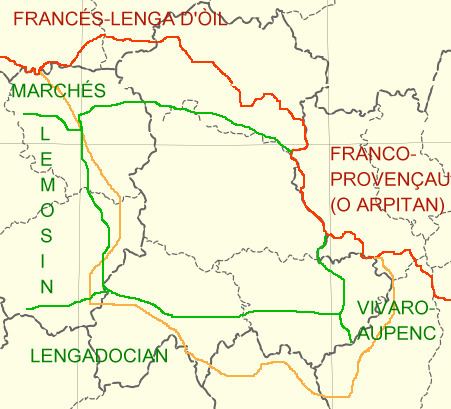Native to France Glottolog auve1239 | Native speakers 1.3 million (2004) Linguasphere 51-AAA-gi | |
 | ||
Region Auvergne, Puy-de-Dôme, Haute-Loire, Allier, Cantal, Communities in Limousin Language family Indo-European
Italic
Romance
Western
Gallo-Romance
Occitano-Romance
Occitan
Northern Occitan
Auvergnat | ||
Auvergnat (French name) or Auvernhat (native name) is one of several varieties of the Occitan language spoken in Auvergne, which is a historical province in the northern part of Occitania, the southern third of France, a historical region where the modern Occitan language is still spoken.
Contents
- Geographical Distribution
- A more precise view on Auvergnat boundaries
- Language boundaries
- Dialect boundaries
- Definition boundaries
- Internal variation
- Subdialects
- Linguistic Vitality and Usage
- Authors
- Poets
- References
Auvergnat has become known internationally through the folk song arrangements of Joseph Canteloube.
Geographical Distribution
The effective borders of Auvergnat do not completely coincide with those of the current Region of Auvergne or the historical region of Auvergne but can be described as follows:
A more precise view on Auvergnat boundaries
There are strong oppositions between Pierre Bonnaud (for whom the Auvergnat is a language of its own, see the light orange line on the map – note it is including the easternmost part of the Marchois dialect) and for instance Roger Teulat.
Language boundaries
Light blue area labelled fr is for French-Langue d’Oïl. Light purple area labelled frp is for Francoprovençal.
Dialect boundaries
Definition boundaries
These are not characteristic of Auvergnat as a whole but allow for defining a boundary:
Note that most Occitanists use rather 7 than 8 to define the southern boundary.
Internal variation
Note some of the definition boundaries allow defining an internal variation. The most traditional one between Lower or Northern Auvergnat and Upper or Southern Auvergnat is the mutation of s before [k], [p], and [t] (line 9). Lower Auvergnat, defined by Teulat, is the light green area labelled 1 on the map. Upper Auvergnat, defined by Teulat, is the light brown-yellow area labelled 2 on the map. A broader area (light yellow) is generally defined. A Northwestern Auvergnat may be defined as well by 5 and 6. The Northeastern (East of 5 and 6, North of 9) has, according to Bonnaud, a stronger influence from French phonetics (a bit like Marchois).
Subdialects
Auvergnat is most often categorized in the Northern Occitan dialect group, along with Limousin and Vivaro-Alpine.
There are two primary distinctions in Auvergnat:
The suggestion that Auvergnat is an independent language, distinct from Occitan, has found little resonance with linguists, especially Romance linguists. It is strongly defended by those who espouse the norme bonnaudienne a standardization of Auvergnat.
Linguistic Vitality and Usage
An understanding of the vitality and overall usage of Auvergnat can be garnered from a survey carried out in 2006 in the Auvergne region.
The largest group of the two languages spoken in the Auvergne region is referred to as patois (78% of the population) compared with other regional terms, with certain cultural identities emerging, such as auvergnat (10%), occitan (8%), bourbonnais (5%) or langue d’oc (4%).
The regional language, whether Occitan (in the whole of the Auvergne region) or Oïl (the north of Allier), represents a strong presence in the region:
A large part of the population that understands or speaks even a little or, moreover, fluently, neither know how to write nor read in that language.
Language learning is found to be essential within the home, according to the survey, (grandparents noted as 61%, or other family members at 50%) with a very weak result from the schools (10%). Herein is found the problem of language-transmission when dependent upon State sponsorship. 40% of adults who did not teach their language to their children report regretting it at the time of the survey. This feeling is reported more strongly among the 35 or less demographic, at 58%. The desire to learn the local language is reported strongly, with increasing representation among the young, reported at 23%. According to the survey the desire to incorporate local language learning in schools is as follows: Haute-Loire (53%), Puy-de-Dôme (51%) et Cantal (74%). The desire to teach to their own children is strong (41%) and is stronger still with the 35 and under demographic (58%). 71% of the region's inhabitants are favorable to the idea of maintaining the regional language and culture, with a stronger result in the 35-and-unders (76%). To achieve this desire, different institutions are expected to play a role (in percentage of those surveyed):
Authors
The following are authors who have published in Auvergnat:
Poets
Poets using Auvergnat:
